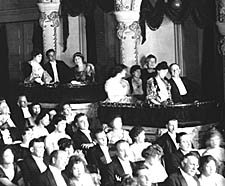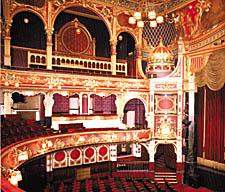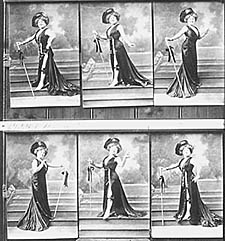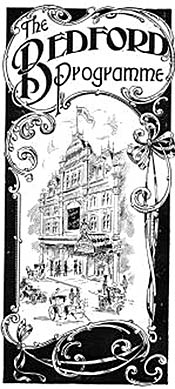|
|
 |
| |
That's entertainment!
The music halls were pioneers of mass entertainment long before cinema and TV, writes Amanda Sebestyen
Lost Empires by Nigel Fountain
Cassell, £19.99
IF you walk along Camden High Street, between the Jobcentre
and Oxfam you’ll find an alleyway blocked by bollards.
Here runs Bedford Passage, renamed Mary Terrace within the last
year and thus obliterating the last trace of one of London’s
premier entertainment venues.
The New Bedford Palace of Varieties opened in 1899 and hosted
superstars of Edwardian music hall such as Marie Lloyd, George
Robey, male impersonator Vesta Tilley, and a very young Charlie
Chaplin.
Down the road the posher Royal Camden Theatre opened with Ellen
Terry performing Shakespeare but quickly moved over to popular
culture, becoming in turn the Hippodrome variety theatre, Gaumont
cinema, a BBC recording studio, Music Machine nightclub, the
Camden Palace and now KoKo – the last two magnets for young
clubbers from around the world.
These traces of vanished halls and international entertainment
routes are home territory for Nigel Fountain, the Kentish Town-based
author whose latest book Lost Empires is the story of a quest.
“Doing the book was an adventure for me,” says Fountain.
The title links the British Empire to those other Empires of
spectacle that sprang up in its heyday, the music hall palaces
extending from Shoreditch to Sunderland.
Fountain’s journey goes back to the Regency London entertainment
gardens along the river. One of the most haunting moments comes
when he cycles up to the solitary gates of the Cremorne –
closed down, he says, as “the biggest open-air brothel
in Europe” – but also the wondrous firework scene
of Whistler’s once controversial painting Nocturne in Black
and Gold. From here the history of Lost Empires’ moves
on through scurrilous pub entertainments and ‘penny gaffs’
in the 1840s, to a mid-Victorian breakthrough – new spectacular
‘temples to music and the arts’, inspired by the Crystal
Palace and aiming at large respectable family audiences. Of
course bawdiness and double-entendre kept breaking through as
mass music hall developed – and there were ongoing battles
with feminist moral purity campaigners who disliked the exploitation
of women’s bodies in bondage scenes.
On another level the starting point of the book is the author
himself, a late child of the British Empire watching ‘The
Queens’ Elizabeth and Mary set out from the docks in Southampton
where he was born and bred. Fountain’s maternal grandfather
James Douglas Gordon – projectionist of the Alexandra Cinema,
Southampton before he joined up and fell in World War I –
is a potent influence between the lines, inspiring the book’s
fascination with Variety as a latter-day ‘Atlantic Trade’
in blackface minstrels and fake Chinamen, conjurors, escape
artists and drag experts of both sexes.
Fountain recalls his own first experience of live theatre, viewing
Cinderella from the dizzying gallery of the Southampton Empire
Theatre and feeling as if he might float off into space. His
taste for high-pitched spectacle must get satisfaction from
his vertical house in Kentish Town (formerly the home of that
brilliantly British character actor, Denholm Elliott), with
its double height windows and rooftop terrace with panoramic
views of the north London heartland.
Fountain remembers one Hackney day around 1970, pushing his
way curiously through a dark foyer into a mainly-empty hall
where scattered pensioners played Bingo in a sea of plastic
cups. It was the old Hackney Empire.
Goodbye to all that, he thought wrongly. Over time Fountain
came to recognise that the “deranged idealists and dreamers”
who wanted to make the old monument into a working contemporary
variety theatre were actually right. He joined the Empire’s
board just over a decade ago.
Then he realised there were many more of those nutters out there,
and set out to map them for the book. He found thriving Empires
in Sunderland, Liverpool, Edinburgh (now the Festival Theatre)
and Southampton (now the Mayflower), all places “where
local councils and the Arts Council have created a highway for
Andrew Lloyd Webber and Clear Channel”. Grand spectacle
rules once more and motorways bring in a wider regional audience.
At the opposite extreme was an amusement arcade in Cleethorpes,
with one last stained-glass window boarded up behind the machines
and the old theatre roof become a dark and dusty vault where
boys play with laser guns. Yet even here, the proprietor has
a drawer full of 1940s posters from when the Cleethorpes Empire
did repertory. “This wasn’t some John Betjeman, this
was just a man who cared,” Fountain states.
In Lost Empires, he always comes back to the success in Hackney:
the Empire building now restored to its Moorish glory, gilded
domes and Alhambra arcades owing their survival to an indomitable
band led by radical theatre veterans Roland and Claire Muldoon,
gathering up Gerry Hall and Gryff Rhys Jones along the way.
Panto is a jewel in this Empire’s crown – Jack and
the Beanstalk this year, Cinderella next – lauded by critics
and audiences alike.
But perhaps the amazing thing about the place is that, in an
age of niche marketing and focus groups, there are now packed
audiences at an independent music hall for black theatre, visiting
opera, clown genius Slava Polunin, the latest Korean martial
arts and every variety of stand-up comic and cabaret. Variety
is alive and flourishing. |
|
 |
|




